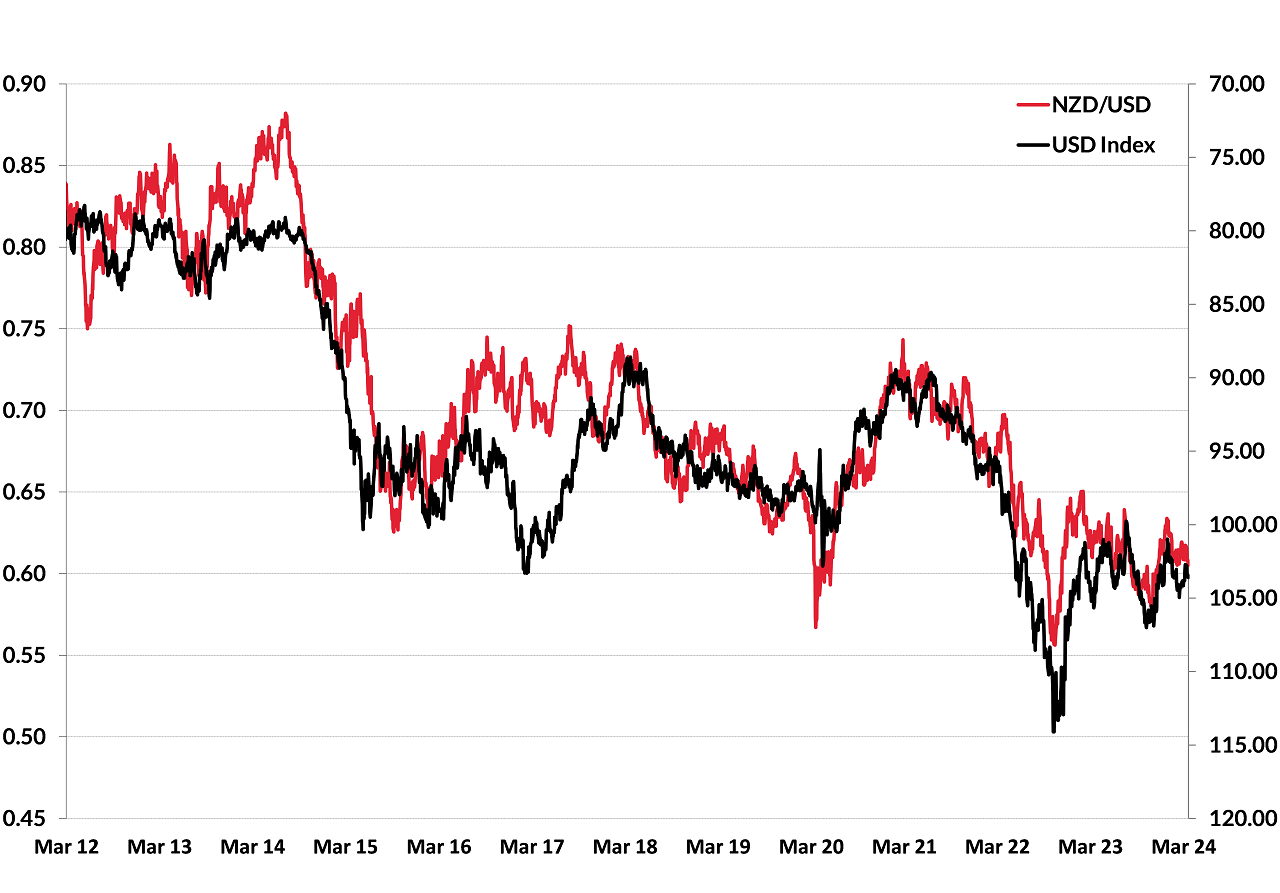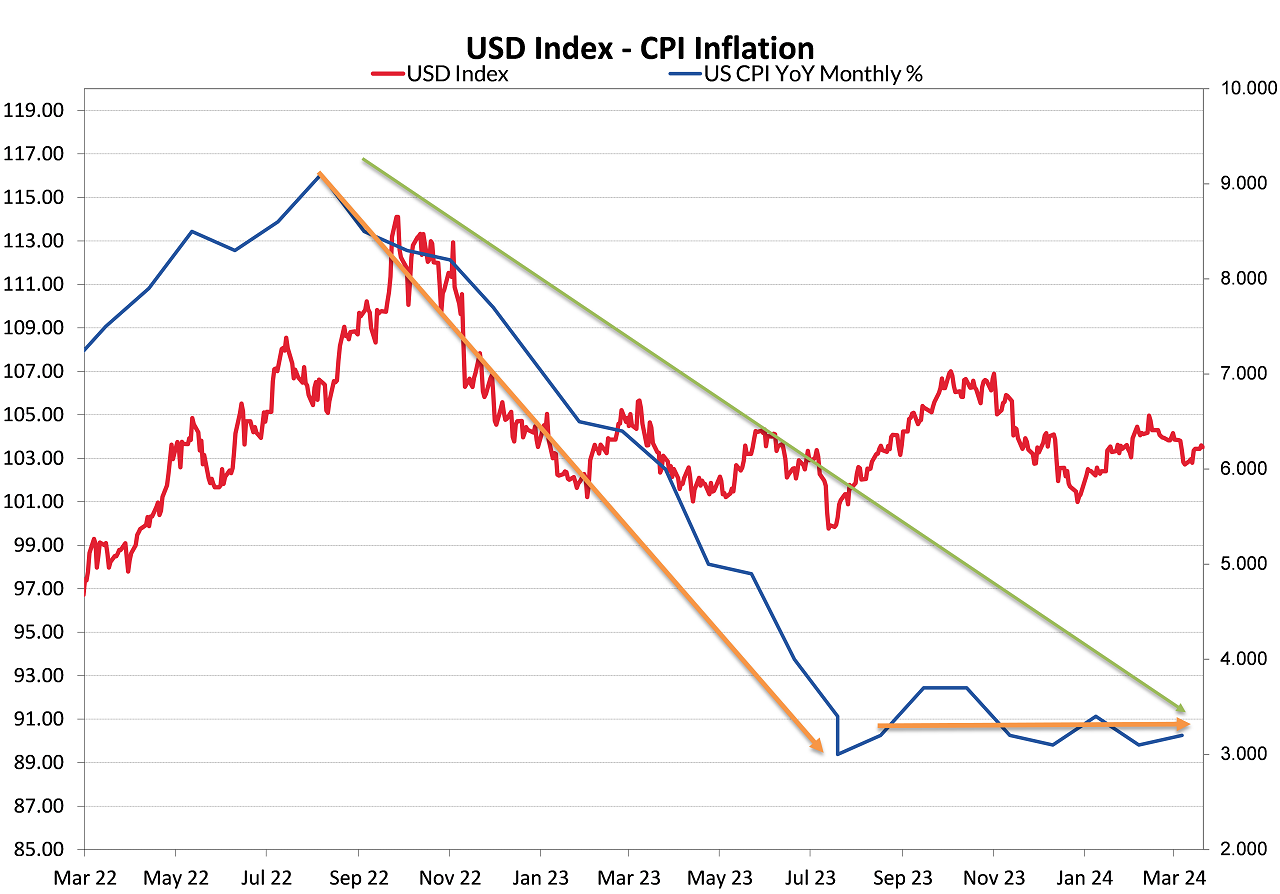
- Does a weak New Zealand economy lead to a weak NZ dollar?
- All tolerant Federal Reserve still on-track to cut interest rates
Does a weak New Zealand economy lead to a weak NZ dollar?
New Zealand’s demise into a double-dip economic recession – bad luck, or bad management?
The answer to that question is undoubtedly the latter, as our economy under-performs all other western economies in the GDP growth stakes in the post-Covid era. Typically, the New Zealand economy slides into recession due to one (or more) of three standard reasons: -
- The global economy is in recession and our export commodity prices tumble as a result.
- Our unfortunate predilection for boom-bust residential property cycles causing inevitable recessions as high interest rates burn-off consumer discretionary spending.
- Climatic conditions (drought) hitting all important agricultural production.
The current economic contraction is due to the second reason with a hint of the third reason, as South Island sheep farmers are seriously challenged with drought and low lamb/sheep meat prices.
However, the root causes of the current economic downturn also has to be sheeted home to just bad management – particularly Government fiscal policy management and RBNZ monetary policy management in response to the Covid pandemic. The decisions of the Ardern Labour Government on shutting the borders (including internal borders), quarantine, vaccines and immigration have led to the economic condition of stagflation we have today. They fundamentally failed to understand that throwing money (all borrowed) at health, social and economic problems is never the solution. Why New Zealand has ended up so much worse off compared to all other countries comes back to the original issue of bad management, we were not at all prepared with the appropriate numbers of acute-care hospital beds required for the risk of a potential pandemic. Because of that unpreparedness, to keep the death rate down, we slammed the borders shut and sprayed the economy with free money. The NZ economic history lesson of “Fool’s Paradise” was ignored.
In hindsight, the fiscal and monetary stimulus applied at the time of the Covid pandemic was recklessly excessive and has directly caused the inflation and zero economic growth problem we have today. Remember RBNZ Governor Adrian Orr’s infamous line of “no regrets” monetary stimulus. Unfortunately, his massive money printing caused the property cycle boom, and subsequent bust, as mortgage interest rates were rapidly ramped up from 3.00% to 8.00%. New Zealand’s high inflation caused by a combination of the Ukraine war supply chain disruptions, ridiculously cheap money and out of control public sector price-setting behaviour. The economy is now paying the price for those excesses. We will look back on 2020 to 2023 as the “lost years” for our communities and the economy.
The question then becomes whether our weak economic predicament automatically leads to a depreciating NZ dollar value? Foreign exchange rates combine three fundamental elements: relative economic performance, relative interest rates and the likely future direction of first two elements. Compared to the US economy, we clearly fail on the first element. However, on the second and third elements the outlook is more positive for the Kiwi dollar. The US Federal Reserve are set to cut their interest rates in June as inflation decreases to their target of 2.00%. The RBNZ have stated that they will not be cutting our interest rates until early 2025. The interest rate markets in New Zealand are pricing-in much earlier cuts in 2024.
However, that forward pricing is likely to be pushed out over coming weeks/months as continuing high domestic (non-tradable) inflation persists, oil prices are higher, and the NZ dollar is lower - all contributing to the annual inflation rate in September 2024 being still well above the RBNZ forecast of 2.60% (currently 4.70%).
Looking forward on our likely economic performance in 2024 and 2025, there are several reasons for “green shoots’ optimism. Foreign tourism is back big time, business confidence has improved dramatically, and the latest Business NZ Performance of Services Index for February was the strongest growth in services in 11 months. Only parts of the economy are contracting. The local media paint a picture of doom and gloom: however, the economic recession is very shallow and not that broad.
However, analysis of economic results/forecasts on the NZ economy really have no bearing on the NZD/USD exchange rate movements as the chart below confirms. The NZD/USD rate is entirely determined by US dollar movements against the major currencies – as measured by the USD Dixy Index. For this reason, the topics of this column are always dominated by the US dollar and the US economy. The NZ dollar held firmer on its own account in 2016/2017, but that was seven years ago. Since then, the NZD/USD rate has tracked the USD Index very closely. A depreciation of the USD from its current 104 level to 95 (inverted righthand axis) would cause a higher NZD/USD rate to the high 0.6000’s. A return of the USD Index to its 2021 level of 90 would see the NZD/USD rate above 0.7000.

All tolerant Federal Reserve still on-track to cut interest rates
The NZD/USD exchange rate increased from 0.6050 to 0.6100 following last Thursday morning’s Fed monetary policy statement and “dot-plot” interest rate forecasts from the individual Fed members. The US dollar weakened sharply from 103.70 to 102.90 as the Fed dismissed market worries that US inflation was at risk of rising again. The Fed seem more confident that the annual inflation rate will fall further to 2.00% after stalling at the 3.00% level for several months now. Chair Powell adding some much-needed medium-term perspective on the decrease in US inflation from 9.00% to 3.00% over the last 18 months. He stated that the Fed did not react to inflation falling faster/further than they expected over the first 12 months period and they have also not reacted to inflation reducing at a much slower pace over the last six months.
The chart below illustrates the point that Jerome Powell was making. If you asked the Fed 18 months ago when inflation spiked to 9.00% and they shoved interest rates up, “would they be satisfied with reducing inflation to 3.00% over the next 18-month period” – the answer would have been a resounding “yes”. It has just happened in two distinct phases that they could not predict.

Unfortunately, the Kiwi dollar gains were short-lived, as the Swiss central bank surprisingly and unexpectedly cut their interest rates last Thursday night. The Swiss Franc and the Euro depreciated as the markets factored in that the ECB could follow the Swiss and cut their interest rates much earlier than previously expected. The EUR/USD exchange rate dropping from $1.0940 to $1.0800, sending the NZD/USD down to 0.6000. A weaker USD/CNY daily exchange rate fixing by the Peoples’ Bank of China on Friday 22nd March from 7.2000 to 7.2260 also hurt the NZD and AUD values.
As the chart above shows, the USD initially followed US inflation lower in 2022. However, through 2023 and into 2024 the USD Index has stopped following inflation lower and has moved sideways between 100 and 107. In 2023, the reason for the bouts of USD appreciation revolved around the higher US Government debt issuance pushing US bond yields higher. In 2024, the USD gains have centred around doubts that the Fed will cut interest rates as the decline in inflation stalls. The US dollar has a lot of catching up to do to the much lower inflation (and interest rate) environment.
Decisions by central banks over coming months will continue to play a pivotal role in the NZD/USD exchange rate direction. The Reserve Bank of Australia is expected push out the timing of any interest rate cuts until 2025 as much stronger than expected jobs data (+116,000 new jobs for February) confirms ongoing wage pressures with no productivity improvements (i.e. inflationary). The AUD/USD rate is expected to bounce up again from 0.6500, dragging the Kiwi dollar up with it. The Bank of Japan disappointed the markets last week with no guidance about further interest rate increases and then Yen weakened as a result. A turnaround is expected in the USD/JPY exchange rate from 151.50 to a much stronger Yen when the inevitable further rate hikes are implemented.
Daily exchange rates
Select chart tabs
*Roger J Kerr is Executive Chairman of Barrington Treasury Services NZ Limited. He has written commentaries on the NZ dollar since 1981.
3 Comments
A few incorrect assumptions in this article.
The government never spends borrowed money, borrowing only removes reserves from the banking system which the governments spending created.
QE is not money printing it is an asset swap where bonds are converted back into reserves and which banks cannot lend out and any money creation was done by the banks themselves.
Inflation was not caused by the government, it was a world wide phenomenon due to covid disruptions to world trade and supply issues and businesses undertaking profit gouging.




We welcome your comments below. If you are not already registered, please register to comment.
Remember we welcome robust, respectful and insightful debate. We don't welcome abusive or defamatory comments and will de-register those repeatedly making such comments. Our current comment policy is here.